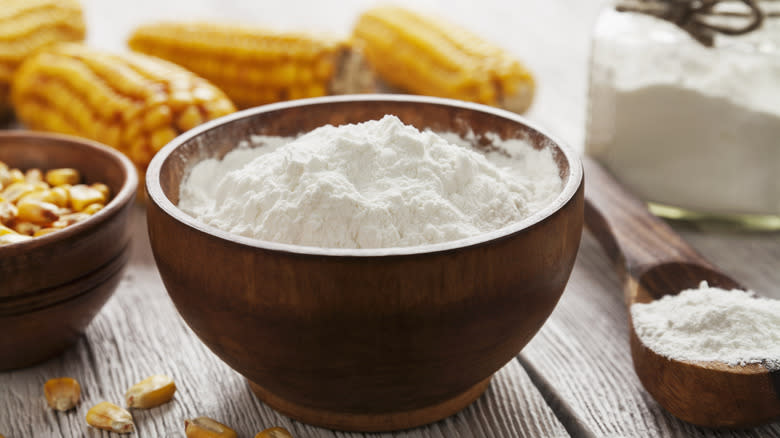The Additional Ingredient You Need For A Custard-Like Egg-Free Pumpkin Pie

If you're planning to make a pumpkin pie for the holidays and run out of eggs or have vegan guests coming for dinner, then you may be searching for a replacement for those eggs in your recipe. For those who don't know, you may be wondering why eggs are make or break to your pumpkin pie recipe. Surely, you can just leave them out, right? Wrong. Without eggs, your pumpkin pie may resemble a pumpkin pudding because eggs are responsible for helping the pumpkin mixture thicken into a custard. The proteins in eggs act as emulsifiers when baking.
You'll need an ingredient that's able to act in the same capacity as an egg. Fortunately, you probably already have some in your cabinet. Grab that box of starch to use as a thickening agent for your pumpkin pie. Fortunately, it doesn't really matter which starch you choose. Consider using cornstarch, potato starch, arrowroot, or whatever you happen to have on hand. Although there are several different ingredients that you can use in place of eggs in a pinch, starch may be your best bet for several reasons.
Read more: Cake Hacks Every Baker Will Wish They Knew Sooner
Why Starch Is The Perfect Replacement

Typically when choosing a replacement for eggs, you have tons of options. For instance, you could substitute eggs with ground cashews, vegan yogurt, or mashed fruit. However, if you're after a thicker texture, then starch should be the way to go. Yogurt and cashews might give the mix a creamy feel, but if your recipe lacks both eggs and heavy cream, your pie might not be as solid as you would like. Starch works the best as a thickener for reasons we will get to in a minute.
Additionally, you should consider the flavor factor. Other egg substitutes have a very distinct flavor that could throw off the overall taste of your pumpkin pie. For instance, chia seeds (a popular egg substitute) have a nutty flavor that might clash with the more earthy, cinnamon tones of pumpkin. Starch is a chameleon in this regard. It has no natural flavor, meaning it can't influence the taste of your pie one way or another. This makes it perfect for purists who want that traditional pumpkin flavor undiluted.
The Science Behind Starch

Starch can work wonders when mixed with liquid. This makes it a secret weapon for many looking for the perfect pie consistency. Although it doesn't have as much protein as eggs, it will act similarly as a thickening agent. However, if you dump cornstarch into a bowl of room-temperature water, then you may be disappointed to find it just clumps up. Heat plays an important role in unlocking cornstarch's thickening properties.
To increase your mixture's viscosity, you must bake it at temperatures higher than 203 degrees Fahrenheit (the starting point for cornstarch to thicken). However, that shouldn't be an issue if you're baking a pie. If you're looking for a smoother texture to your pie then you may want to consider potato starch. However, it generally requires a higher temperature than cornstarch.
Starches contain polysaccharide molecules, which begin to break down at higher temperatures. The starch then bonds with water, absorbing moisture, and therefore thickening the mixture. If you want your pie to be slightly less firm, then consider adding less cornstarch, and likewise, do the opposite if you want it to be firmer. Now, go make that pumpkin pie from scratch.
Read the original article on Daily Meal.


